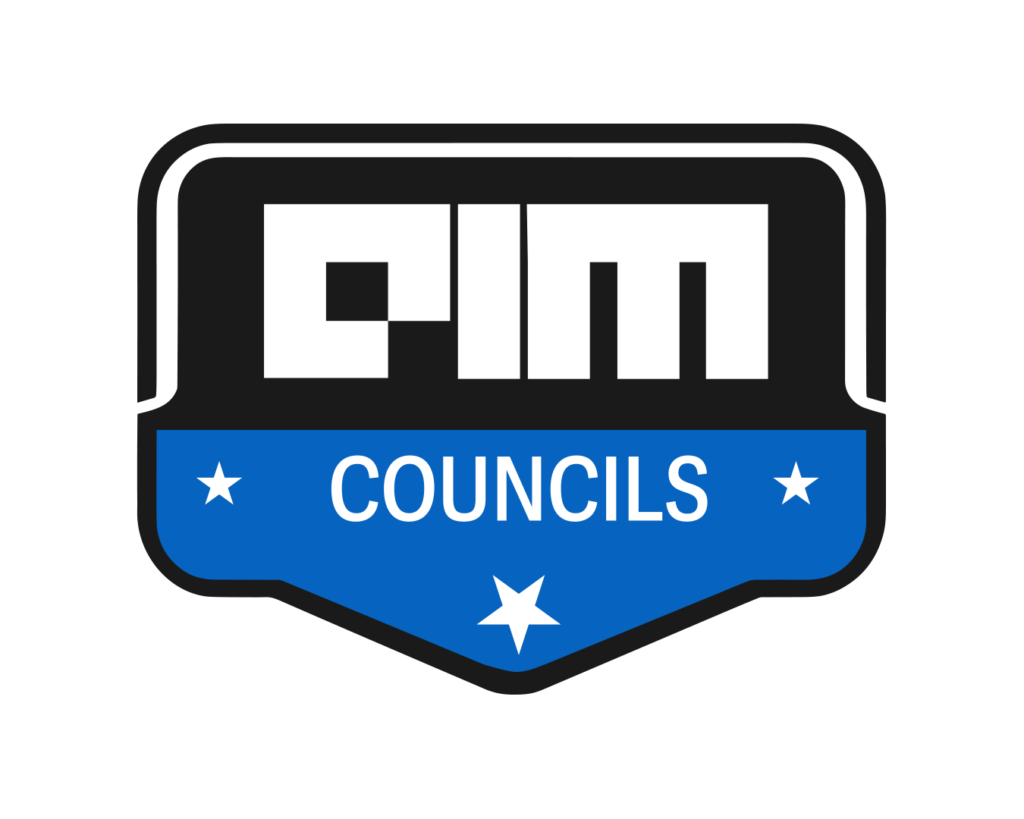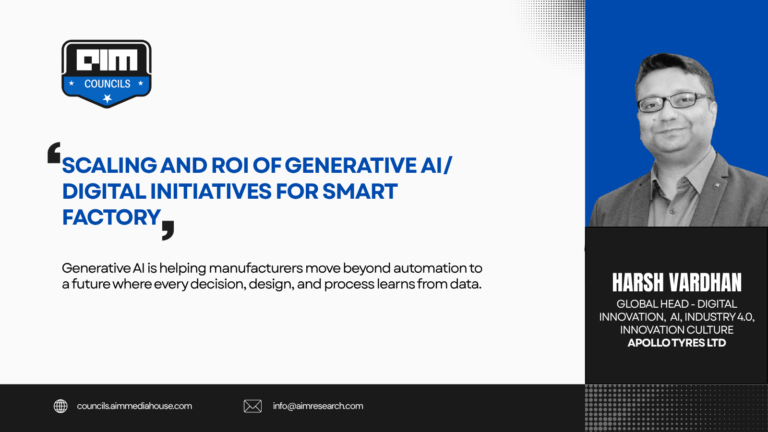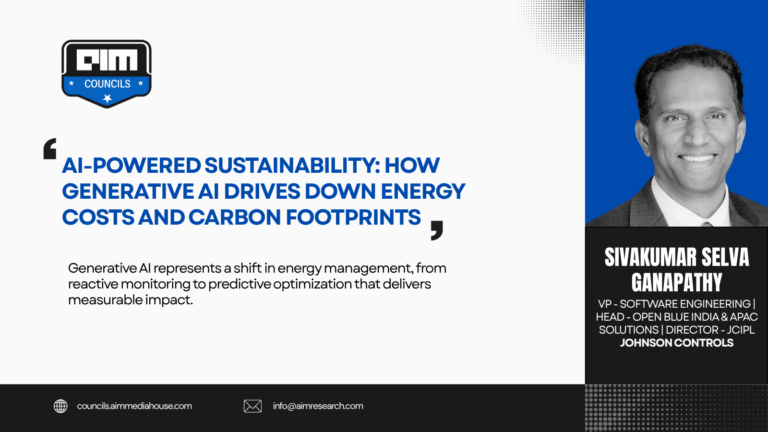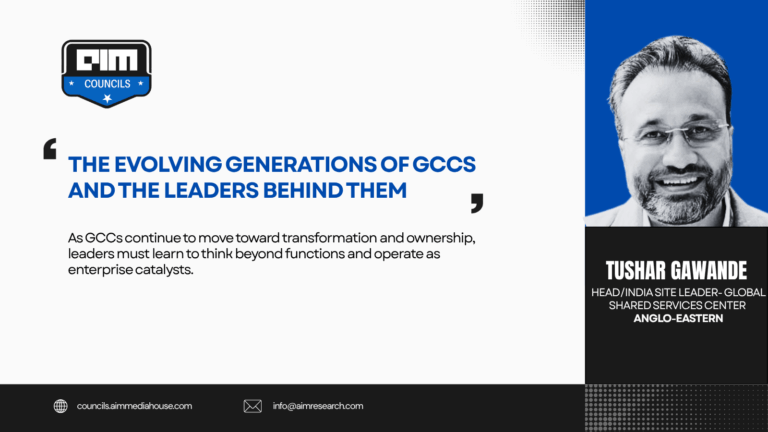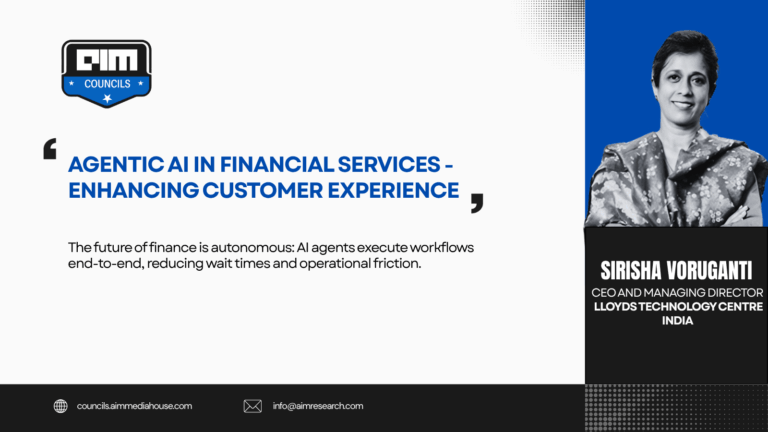AI is now central to how companies transform and grow, but many are stuck running test projects that never go live. Developing innovative ideas isn’t the hard part; the challenge is implementing AI across staff, operations, and tech platforms. C-suite leaders discussed this at a roundtable on how to to maximise AI’s impact across the enterprise
Moderated by Sandeep Sharma -Senior Director AIM Research, the discussion brought together senior executives from diverse sectors: Amit Kalra – Managing Director, Head Global Business Solutions at Swiss Re, Nilesh Iyer-Managing Director, CEO at Natixis Services in India, Shubhosree Dasgupta – Country Data and Analytics Officer at HSBC, Saraswathi Ramachandra – Managing Director/ Country Head at Lightcast, Sreedevi Hegde – Managing Director and Board Member, India GCC Head at Vervent.
Digital transformation has evolved beyond cloud migration and process automation. Today’s AI-first enterprises are fundamentally rethinking value creation itself. Research shows companies embedding AI into core business strategy are twice as likely to outperform peers in revenue growth and profitability. But the path from pilot to production remains fraught with challenges, from data governance and regulatory compliance to change management and ROI measurement. What emerged was a candid exploration of how organizations balance innovation with guardrails, entrepreneurship with governance, and transformation with trust.
Leadership, Change Management, and Upskilling
AI adoption is fundamentally a human challenge, not a technology problem. Successful enterprise transformation requires visible executive sponsorship at the CEO or board level, positioning AI as an enterprise-wide priority rather than isolated technology projects. Progressive organizations now track AI initiatives at board level, making it a top-down strategic agenda.
Leadership must evolve beyond sponsorship to become catalysts who translate business vision into adoption at scale. This demands AI fluency across all leadership levels, not as coders, but as bridge-builders between business needs and technical possibilities. Distributed leadership ensures strategy, finance, and HR carry the transformation forward, not just technology teams.
Change management addresses inevitable resistance through storytelling, real use cases, and psychological safety. Upskilling requires role-specific training tailored to domain needs, fraud analysts need different AI competencies than frontline customer service teams. Cross-functional collaboration breaks down silos, ensuring corporate functions participate in the transformation journey.
Cultural barriers like “it’s worked so far, why change it?” demand collective value appreciation. Organizations succeed by piloting strategically, building momentum through small wins, and fostering continuous learning. The goal: helping employees feel part of the future, not left behind.
Data Quality, Governance and Foundations
Clean, unified, real-time data fabric forms the foundation of AI-first enterprises, extending beyond legacy big data architectures. Quality data ingestion remains the single biggest challenge for unlocking AI value, a bottleneck acknowledged across industries.
Data platforms require federated architectures enabling low-latency integration between external and internal AI models. This infrastructure fuels business insight, regulatory compliance, risk management, and evolving customer needs, demanding continuous investment.
Data governance is non-negotiable: clear policies for data use, privacy, access controls, and audit trails build stakeholder trust. Governance frameworks must be embedded from inception, addressing ethics, transparency, bias mitigation, auditability, cybersecurity, and regulatory compliance, not treated as afterthought checklists.
Model quality and traceability prove crucial for passing audits and building resilient systems, particularly in regulated industries like BFSI and healthcare. Breaking down data silos through cross-functional collaboration between business units, data scientists, and compliance teams catalyzes innovation while protecting institutional knowledge.
Organizations must continuously adapt to evolving regulations globally. Generative AI’s emergence hasn’t solved foundational data challenges, these require ongoing investment, structure, and executive sponsorship at board level. Data governance remains the bedrock of responsible, scalable enterprise AI adoption.
Scalable Platforms and Infrastructure
AI-first architecture demands modular, federated platforms built on real-time data fabric, enabling plug-and-play integration with core business systems. Platform connectivity and interoperability ensure seamless operation across legacy and modern infrastructure.
The journey from pilot to production presents significant scaling challenges. Moving from 200 test users to millions requires stack-based architecture that expands or contracts dynamically, optimizing compute resources and controlling costs. While token costs have decreased, demand for compute power, model variety, and multimodal capabilities has surged proportionally.
Infrastructure decisions around GPU deployment, token budgets, and model selection (Gemini, Anthropic, proprietary solutions) require strategic planning. Organizations must balance technical agility with cost management as AI transitions from experimental to mission-critical systems.
Crucially, scaling extends beyond technology teams. Legal, compliance, and governance stakeholders need early involvement and upskilling to maintain controls during production deployment. Board-level tracking of AI infrastructure has become standard practice in progressive organizations.
Successful scaling requires distributed ownership across strategy, finance, and HR, breaking down data silos while maintaining regulatory guardrails. The infrastructure challenge is simultaneously technical and organizational, demanding cross-disciplinary collaboration to support adoption rates and deliver value enterprise-wide.
ROI Measurement and Iterative Success
ROI measurement proves essential for securing continued AI investment and executive sponsorship, particularly from CFOs demanding measurable returns. Linking AI initiatives directly to business outcomes, improved margins, operational efficiency, risk insights, establishes credibility and momentum.
Clear baseline data enables objective comparison of pre-AI and post-AI performance across diverse KPIs: sales revenue, operational turnaround time, fraud reduction, and customer retention. This holistic measurement approach aligns business and technology teams, ensuring AI remains an enterprise priority rather than fragmented experimentation.
Iterative success through manageable pilots validates impact before broader rollout. Starting small, “eating the elephant one bite at a time”, builds incremental buy-in while tackling complex transformation step-by-step. Demonstrating tangible benefits like faster claim settlements, improved underwriting quality, and personalized customer engagement drives wider acceptance.
When employees see real examples of AI success, it builds confidence and helps overcome hesitation. Leading organisations now monitor AI projects at the board level, making ROI tracking part of their strategy. Using clear metrics turns AI from a trial effort into a core business strength.
Conclusion
AI-powered digital transformation transcends technology implementation, it represents wholesale business reinvention requiring orchestrated organizational alignment.
Across insurance, banking, labor markets, and financial services, leaders converged on essential pillars. Data foundation, clean, unified, real-time, emerges as non-negotiable infrastructure. Governance addressing ethics, bias, privacy, and compliance must be embedded from inception, not retrofitted. Scalable, modular platforms enable the critical leap from pilot to production, balancing agility with cost control.
Yet technology alone guarantees nothing. Human dimensions prove paramount: distributed leadership beyond technology teams, role-specific upskilling creating AI fluency across functions, change management fostering psychological safety, and cross-functional collaboration dismantling silos. CFO-satisfying ROI measurement with clear business outcome linkages secures sustained investment and momentum.
The consensus: AI adoption succeeds as enterprise-wide transformation, not isolated technical projects. Board-level sponsorship, iterative validation through pilots, continuous regulatory adaptation, and collective institutional knowledge-building form the operational reality of mature AI organizations.
Diverse industry contexts yielded unified direction, AI reinvents business models when organizations integrate leadership commitment, robust data governance, scalable infrastructure, human-centric change management, and metrics-driven accountability. This isn’t automation’s evolution; it’s fundamental reimagination of how enterprises create and deliver value.
